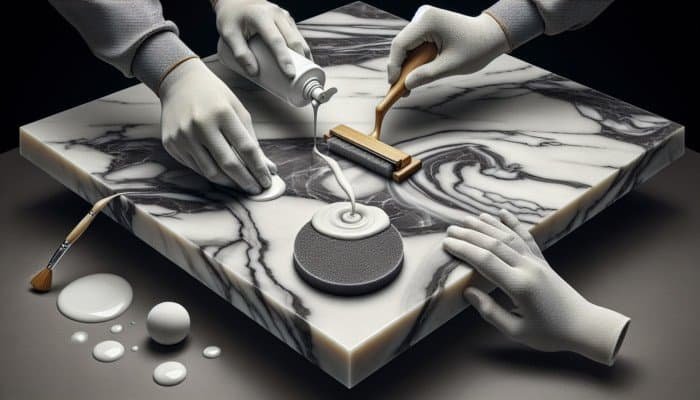


May 23, 2025 by
David Allen
Transform Your Marble: The Ultimate Guide to Expert Polishing and Maintenance
With its enduring elegance and luxurious aesthetic, marble has adorned the interiors of private residences and public spaces for centuries. However, just like any natural stone, marble demands careful maintenance to preserve its breathtaking appearance. Marble polishing ensures the stone remains visually appealing and the finish endures over time. By comprehensively understanding the nuances of marble polishing, you can maintain its visual allure and extend its lifespan, making it a truly worthwhile investment for the future.
Understanding the Unique Characteristics of Marble
Before embarking on the polishing process, it is crucial to grasp the unique characteristics of marble itself. Formed as a metamorphic rock from limestone subjected to intense heat and pressure, marble primarily consists of calcite. It also incorporates minerals like quartz and iron oxides, contributing to its diverse colours and patterns. The specific type of marble you possess significantly influences the appropriate polishing methods. Take, for instance:
Each type of marble possesses distinct characteristics that dictate the appropriate care and polishing techniques required.
Executing the Comprehensive Steps of Marble Polishing
Marble polishing is a meticulous, multi-step process that demands attention to detail and the correct materials. The initial stage, preparation, is imperative for ensuring the surface is primed for polishing. This entails an exhaustive cleaning to eliminate dust, dirt, and debris, typically using a pH-neutral cleaner that will not harm the stone. Any chips or cracks in the marble must be repaired using epoxy or resin to create a smooth, even surface conducive to polishing.
Once the preparation is complete, the process advances to grinding. This critical step removes surface imperfections, including deep scratches and unevenness. Diamond abrasives or grinding pads of varying grits are employed to achieve the desired results. The damaged and uneven surface is effectively removed, starting with a coarse grit, resulting in a smooth, monolithic finish.
Next, we progress to the honing stage, where light surface scratches or marks from grinding are eliminated. This process utilises finer diamond pads or honing powders, which bring the stone closer to a polished state but yield a satin-like finish rather than a high gloss.
The polishing phase is where the transformation truly occurs. The marble’s surface is meticulously worked by polishing powders or pastes alongside buffing pads until it achieves a glossy, reflective finish. This step accentuates the stone’s inherent beauty, showcasing its colour and intricate veining.
Finally, a penetrating or impregnating sealer is applied to safeguard the polished marble against future stains and spills. Penetrating sealers provide a protective barrier without altering the stone’s natural appearance, ensuring your marble remains stunning for many years.
Crucial Equipment and Materials Required for Marble Polishing
Successful marble polishing hinges on having the right tools and materials. Whether hand-held or larger, polishing machines are equipped with rotating pads that apply the necessary pressure and movement for effective polishing. Diamond pads are indispensable, varying from coarse to fine grits according to the specific stage of the polishing process. Additionally, specialised polishing compounds, available in powders and pastes, are formulated to complement the natural properties of marble, enhancing its shine without causing damage.
Advanced Polishing Techniques for Flawless Results
Achieving a perfect marble polish is a delicate interplay of technique, experience, and meticulous attention to detail. From the initial grinding to the final buffing, each step requires precision to achieve an impeccable finish. When executed with expertise, the techniques detailed below ensure that marble surfaces look their finest and retain their beauty for years to come. Whether revitalising an old marble floor or polishing newly installed marble, these advanced techniques are essential for reaching the highest standards of craftsmanship.
Grinding machines are vital for levelling and preparing marble surfaces for the subsequent polishing stages. These powerful machines operate similarly to large drills, necessitating a skilled operator to prevent irreversible damage. A key technique involves maintaining consistent, overlapping passes during the grinding process. This approach ensures even material removal across the surface, avoiding the creation of grooves or low spots that could lead to an uneven finish. Professionals typically work in a systematic grid pattern, diligently monitoring the machine’s progress to guarantee that the entire surface is uniformly ground.

Honing is the process of smoothing the marble after grinding but before polishing. It effectively removes minor scratches and prepares the surface for the final polish. Although the honing machine is less aggressive than a grinder, it still demands precision. Experienced operators understand that uneven pressure or inconsistent movement can result in a patchy surface, ultimately leading to an unsatisfactory and uneven polish. The honing process is generally performed using progressively finer grits of diamond abrasives, gradually refining the marble’s surface to achieve a uniform, satin-like finish.
Polishing powders are frequently utilised to achieve the final shine on marble surfaces. These powders typically contain acidic compounds that react with the marble, creating a smooth and glossy surface. However, improper application of these powders can lead to “burning” or etching, which are forms of surface damage that dull the marble’s appearance. Experts meticulously control the quantity of powder used and the pressure applied during polishing to prevent this. They also ensure the surface is adequately lubricated with water, helping to dissipate heat and avoid damage.
A consistent polish epitomises expert craftsmanship. This involves making precise, uniform passes over the marble surface with the polishing equipment. Professionals recognise the importance of maintaining a steady speed and consistent pressure throughout polishing. This consistency helps to eliminate swirl marks and streaks, resulting in a mirror-like finish that highlights the marble’s natural veining and colour. Additionally, skilled polishers often switch between different types of polishing pads, commencing with coarser pads and transitioning to finer, softer ones to achieve the desired level of shine.

Following the polishing process, sealing the marble is essential to protect it from stains and moisture. An expert understands that the sealant should be applied evenly and allowed to penetrate the stone thoroughly. Once the adhesive has cured, a final buffing with a soft, clean pad enhances the marble’s gloss and ensures smooth surfaces. This concluding step is about aesthetics and longevity, as a well-buffed and sealed marble surface is more resistant to wear and tear.
Preserving the Radiance of Polished Marble
After the polishing process, maintaining the marble’s shine requires regular care. Cleaning with microfibre mops and pH-neutral marble cleaners is vital to avoid damaging the surface. It is imperative to avoid harsh chemicals that can cause etching or dullness. Depending on usage levels, reapplying a sealant every 6 to 12 months will continue to offer protection, keeping your marble at its best.
Addressing Common Marble Issues
Despite your best efforts, marble can still face challenges. One common issue is etching, which occurs when acidic substances, such as lemon juice or vinegar, come into contact with the marble, resulting in dull spots on the surface. These blemishes can often be polished out using specialised polishing creams. However, it’s essential to initially test the polishing technique on a hidden area or a sample tile to ensure satisfactory results and compatibility with the specific type of marble. This precaution helps prevent unintentional damage and ensures a flawless, professional finish. Staining can be effectively managed using marble-specific stain removers or by applying a poultice, which extracts the stain before the surface is re-polished. Selecting a stain remover and poultice compatible with polished marble is crucial, as some products may etch or damage the surface if not correctly formulated for use on this delicate material. If the marble appears dull over time, regular maintenance and occasional re-polishing will restore its brilliance.
Comparing DIY Marble Polishing to Professional Services
DIY marble polishing can be a viable option for those tackling smaller areas or minor imperfections. However, it necessitates time, effort, and the right tools to achieve a professional finish. Hiring professional services is paramount for larger areas, deep scratches, or significant damage. Professionals bring invaluable expertise and advanced equipment, ensuring your marble is polished to perfection.
Prioritising Safety and Environmental Responsibility in Marble Polishing
When polishing marble, it is essential to prioritise both safety and environmental considerations. Proper ventilation is crucial when working with chemical sealants or polishers, as this helps prevent inhaling harmful fumes. Many marble polishing powders contain fine acidic crystals that can irritate the respiratory system, so wearing appropriate protective gear, such as masks, is vital for safeguarding health. Whenever feasible, we opt for eco-friendly, biodegradable, and non-toxic products, contributing to a safer environment while preserving your marble surfaces.
Achieving Marble Perfection through Expert Polishing
Polishing marble restores its shine and preserves a piece of nature’s artistry. Whether you undertake the task yourself or rely on professional expertise, understanding the process and materials involved is crucial for achieving a stunning, enduring finish. With the proper care, your marble surfaces will continue to captivate and impress, embodying timeless beauty.
[How often should I polish my marble floors?]
The frequency of polishing your marble floors hinges on the foot traffic and wear they endure. Polishing may be required every 1-2 years in high-traffic areas, while in low-traffic areas, every 3-5 years could suffice. Regular maintenance, including cleaning and sealing, can extend the interval between polishing.
[Can I polish marble myself, or should I hire a professional?]
While DIY marble polishing is feasible with the appropriate tools and techniques, enlisting professional assistance is advisable for optimal results. Professionals possess the expertise and equipment to achieve a flawless finish and can manage necessary repairs and levelling.
[What is the difference between honing and polishing marble?]
Honing involves using abrasives to eliminate surface imperfections and create a smooth, matte finish. In contrast, polishing refines the surface with finer abrasives and polishing compounds to produce a high-gloss, reflective finish. Both steps are integral to restoring and maintaining marble surfaces.
[Is it necessary to seal marble after polishing?]
Sealing marble post-polishing is vital to safeguard the surface against staining, liquid penetration, and other potential damage. A high-quality sealer establishes a protective barrier that helps maintain the polished marble’s beauty and durability.
[What are the best products to use for cleaning marble floors?]
For cleaning marble floors, it is advisable to use a pH-neutral, non-abrasive cleaner specifically formulated for natural stone. Steer clear of acidic or abrasive cleaners, as these can damage the marble. Regular cleaning with a soft cloth or mop will help uphold the marble’s shine and protect it from harm.